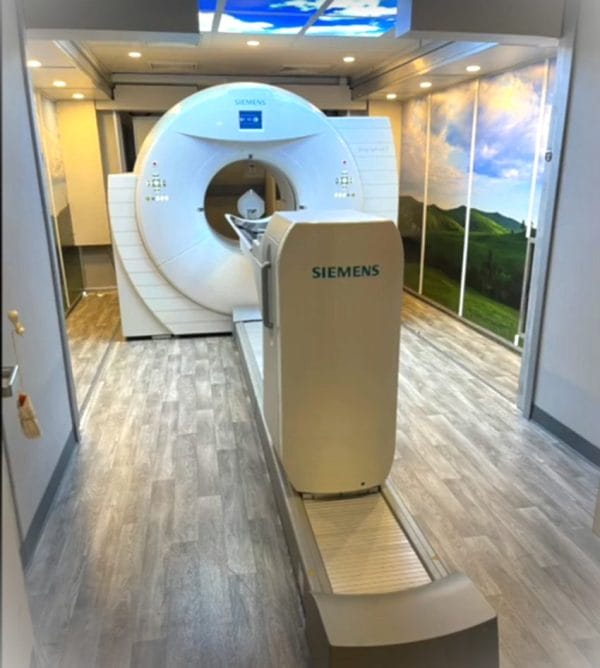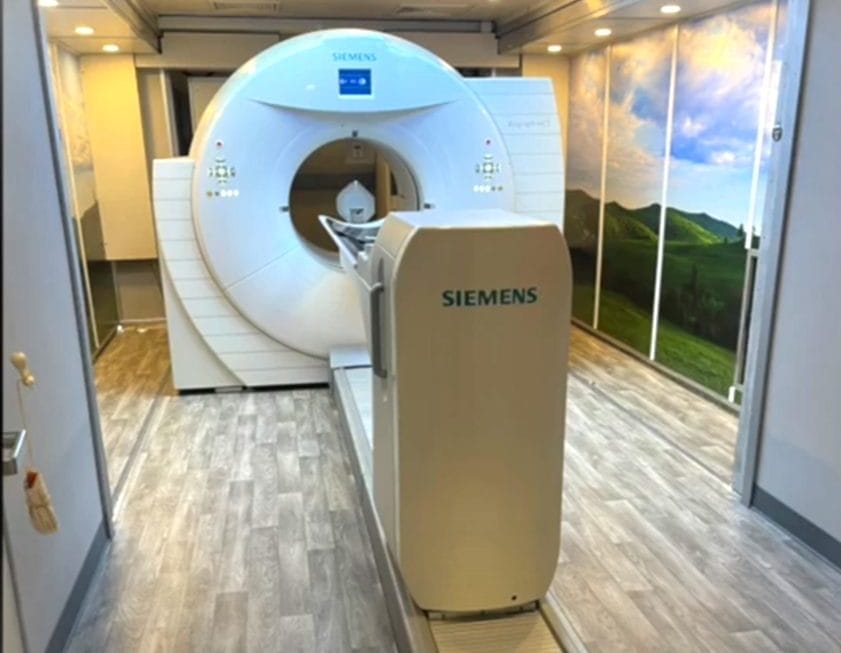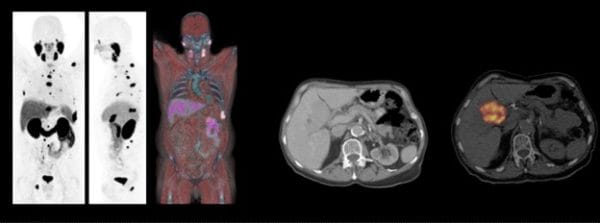 Biograph mCT is engineered as a true dual modality scanner, which integrates the best performance of both PET and CT into a single compact system. The PET technology that takes you further is a reliable, sustainable, and proven technology that allows you to start from a position of clinical power. The CT configurations offering up to 128 slices per rotation, this system delivers all the capabilities of a high-end standalone CT, including intervention functionality, enabling potential revenue generation through dedicated CT scans. By requiring only, a single room and one team, it helps save space, time, and costs.
Biograph mCT is engineered as a true dual modality scanner, which integrates the best performance of both PET and CT into a single compact system. The PET technology that takes you further is a reliable, sustainable, and proven technology that allows you to start from a position of clinical power. The CT configurations offering up to 128 slices per rotation, this system delivers all the capabilities of a high-end standalone CT, including intervention functionality, enabling potential revenue generation through dedicated CT scans. By requiring only, a single room and one team, it helps save space, time, and costs.
AIDAN(Artificial Intelligence for Diagnostic Assistance and Navigation) software on PET/CT scanners leverages artificial intelligence and machine learning to assist in interpreting and analyzing medical images. AIDAN is designed to enhance the workflow of clinicians by automating certain tasks, improving accuracy, and increasing efficiency in reading PET/CT scans.
Here’s what AIDAN typically does:
- Automated Lesion Detection and Characterization: AIDAN helps in automatically identifying potential areas of concern, such as tumors or lesions, by analyzing the images from both PET and CT scans. It can highlight suspicious areas that may require further attention, reducing the chance of human error.
- Quantification of PET Data: It can help with the quantification of PET scan data, such as calculating Standardized Uptake Values (SUVs), which are useful in assessing the activity of lesions and helping in the diagnosis and treatment planning, especially in oncology.
- Image Fusion and Co-Registration: AIDAN software can assist in aligning or co-registering the PET and CT images more accurately. This ensures that the metabolic information from the PET scan is precisely matched with the anatomical details from the CT scan.
- Improved Workflow Efficiency: By automating repetitive tasks like segmentation (outlining regions of interest) and quantification, AIDAN can reduce the time required for radiologists or nuclear medicine specialists to interpret scans, allowing them to focus more on decision-making.
- Decision Support: AIDAN may provide decision support tools, offering insights based on patterns in the images, past cases, and clinical data to guide the clinician in making more accurate diagnoses and treatment decisions.
Time of Flight (TOF) software on PET/CT scanners enhances the quality and accuracy of positron emission tomography (PET) imaging. In PET scans, the scanner detects gamma rays produced when a positron emitted from a radiotracer annihilates with an electron in the body. These gamma rays travel in opposite directions, and by detecting the time difference between their arrival at the scanner, TOF software can provide more precise localization of the annihilation event.
Here’s what TOF software does specifically:
- Improves Image Quality: By using the time difference between the arrival of the gamma rays, TOF helps reduce noise and improve the signal-to-noise ratio in the images. This results in clearer, more detailed images.
- Reduces Scan Time: With improved image quality, it may be possible to reduce the time needed for a scan, improving patient comfort and throughput.
- Enhanced Sensitivity: TOF helps increase the sensitivity of the PET scan by more accurately pinpointing where the radioactive tracer has accumulated in the body, which can help detect small or subtle lesions.
- Better Resolution: The software contributes to better spatial resolution, making it easier to detect and characterize lesions, which is especially useful in oncology and neurology.
Overall, TOF technology on PET/CT scanners improves diagnostic accuracy, especially in complex cases like small tumors or areas with low metabolic activity.
Biograph mCT supports the clinical development of PET/CT imaging in Oncology, Cardiology, and Neurology. Delivering solutions for diagnostic, theranostic, RT planning and research imaging.
ONCOLOGY, expand capabilities beyond traditional PET/CT imaging with Biograph mCT. Designed to support low-dose and fast imaging, biograph mCT enables a comprehensive oncology imaging workflow. Dedicated technologies, such as deviceless gating, whole-body dynamic imaging, and RT planning packages reveal critical details while ensuring patient comfort and care.
All photographs and data are a courtesy of Siemens Healthcare GmbH.
CARDIOLOGY, biograph mCT delivers a fast and reproducible cardiology workflow. Digital LSO-based detectors enable routine use of short-lived isotopes for cardiac imaging. Cardiac dedicated features deliver automated PET and CT data registration and fast reconstruction of dynamic datasets simultaneously with acquisition.
All photographs and data are a courtesy of Siemens Healthcare GmbH.
NEUROLOGY, neurology imaging workflows benefit from Biograph mCT’ s precise delineation of cerebral anatomy with TOF and small, 4 x 4-mm elements—including 78-mm 3 volumetric resolution and a large 400 x 400 acquisition matrix.
All photographs and data are a courtesy of Siemens Healthcare GmbH.
A next level experience.
The Biograph mCT’ s large bore and weight capacity combined with AIDAN—our intelligent imaging platform for Biograph PET/CT—let you deliver an enhanced patient and user experience. Accommodate all patients1 and procedures for both PET and CT with optimized patient positioning and an easy-to-use interface. AI-powered features enable automation for faster, more reproducible workflows—giving you more time with your patients.
Short 136-cm tunnel
- Reducing patient claustrophobia and more room for patient positioning
78 cm Bore
- Easy patient access and positioning of external accessories
Large Patient Imaging
- Wide pallet that holds up to (500 lbs.) and allows 2-meter scan ranges
Exclusive bed design
- Zero differential deflection for accurate attenuation correction
Siemens vs. GE PET/CT Comparison and Advantages:
Both the Siemens Biograph, and the GE Discovery series are popular and widely used PET/CT scanners in clinical and research settings. Each has its strengths, but overall, the Siemens Biograph tends to have a slightly larger share of the market, especially in Europe and certain research environments. However, the GE Discovery series also remains highly popular, particularly in North America.
Here are some considerations for each:
- Siemens Biograph:
- Known for high image quality, advanced imaging technologies, and efficiency.
- Offers a range of models (e.g., Biograph mCT, Biograph Vision) with cutting-edge features like high-resolution imaging and time-of-flight (TOF) technology.
- Often preferred in research settings due to the availability of advanced options for molecular imaging.
- GE Discovery:
- Renowned for its reliability and ease of use.
- GE’s PET/CT scanners are widely used in clinical settings, particularly in North America.
- The Discovery series also includes advanced features like time-of-flight technology and sharp imaging capabilities.
Ultimately, the choice between the two depends on factors like specific imaging needs, the type of clinical or research application, budget, and geographic location. Both systems are highly regarded in the medical imaging community.





